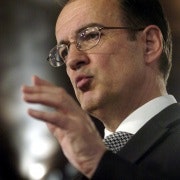TECHNOLOGY SPECTATOR: Turnbull's network bungle
It's difficult to envy Malcolm Turnbull's job when it comes to the NBN. Explaining how the Coalition will come up with a "cheaper, faster” network is no small task.
His alluring promise has been out there for months, and until last week we had little sense as to how it would be accomplished.
The smart money was on the Coalition putting forward a national broadband policy platform that would simply see the overhaul of NBN Co. The recent slew of failures plaguing the rollout has given the opposition ample justification for such an action.
Many NBN followers could probably already imagine the "under new management” banner hanging off NBN Co's website.
Yet, when Turnbull went on the ABC's Lateline last week, he pitched the nation a curve ball. He brought Telstra's HFC network back into the fray.
Unravelling the HFC Plan
Fronting the cameras, Turnbull said his NBN plan included utilising Telstra's HFC cable network and that areas that were within Telstra's HFC footprint would not be prioritised for NBN fibre rollout. Telstra's HFC cables are currently being used to ferry Foxtel's services to dwellings.
"You wouldn't be overbuilding the HFC [Telstra's cable network] areas in the near term because they're getting very good service already,” Turnbull said.
Yet, a quick trip to the inner city areas of Melbourne seems to point to the contrary.
Along many of the streets we see the Telstra and Optus HFC cables strung beneath the power lines yet when we turn our eyes left and right we see hundreds of satellite dishes that provide satellite pay television services. Why? Because as it stands HFC networks have avoided multi-dwelling units.
Indeed, the inner city areas are connected to services like Foxtel through a mess of technologies. Some harness ADSL2 , others use the HFC, and some even use satellite. Under the Coalition's plan, people in these areas would be forced to use these services for internet access.
It's these areas that desperately the NBN to help streamline the technology being used to connect to the internet. Yet since the Coalition's plan advocates that area's with the HFC they would be the last to receive any attention.
To add to the confusion, Turnbull told Computerworld that the Coalition would honour existing NBN contracts and possibly negotiate further contracts that permitted a fibre to the node rollout.
Given this, the Coalition plan would also include renegotiating contracts worth $12 billion, adding two technologies to the NBN rollout and reorganising the existing NBN rollout plan to take the coalition changes into account.
Another problem for the opposition is the limited data capacity of the Telstra HFC network. This network was intended for pay-tv services, not ubiquitous high-speed internet access.
Not everyone who has access to the HFC is hooked up to the HFC, which raises doubts how network speeds would cope if it this type of cable was used to connect everyone to the internet.
If the plan was to go ahead, we could see Telstra announce that its network is not capable of the 100Mbps speeds promised by NBN Co.
Neglecting competition
The coup de grace for Turnbull's plan is the coalition failure to understand (or remember) one of the root causes for the NBN in the first place – competition.
Last week the Competitive Carriers Coalition (CCC) which includes some of Australia's mobile, fixed line and internet providers, excluding Telstra and Optus, identified what is probably the most important weakness in Turnbull's plan.
If Telstra's HFC network is to be used as a replacement for the fibre network, for up to 10 years, how will companies compete with Telstra in HFC cable serviced areas?
Telstra's HFC network is not designed to be a wholesale product and cannot be made available for wholesale access without considerable effort and cost.
Turnbull's plan will also see both Telstra and Optus attempt to milk the government for compensation for the use of their HFC networks. Turnbull's already criticised the government for paying Optus $800 million to decommission its HFC network, and now he's staring down a plan that could possibly see his government pay tenfold.
There is still six months until the September election. The Coalition has one opportunity to change course and to propose a NBN plan that is doable and sensible. Turnbull must find advisors that can provide a new plan immediately that simply adopts the existing NBN plan and highlights how the Coalition would build a next generation high speed broadband network faster, cheaper and better.
Any other option is folly.













